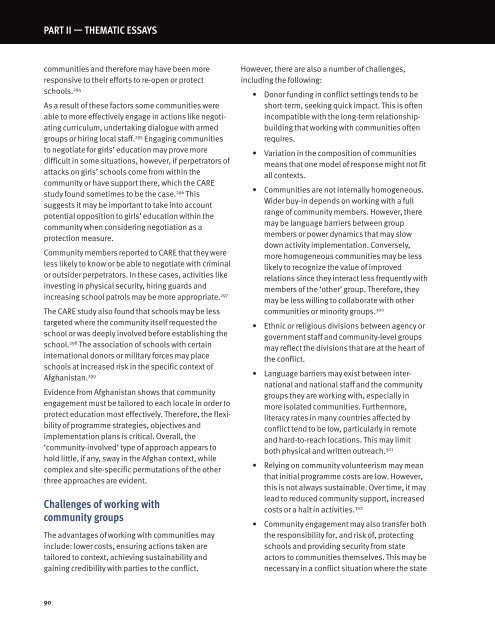Create successful ePaper yourself
Turn your PDF publications into a flip-book with our unique Google optimized e-Paper software.
PART II — THeMATIC eSSAYS<br />
communities and therefore may have been more<br />
responsive to their efforts to re-open or protect<br />
schools. 294<br />
As a result of these factors some communities were<br />
able to more effectively engage in actions like negotiating<br />
curriculum, undertaking dialogue with armed<br />
groups or hiring local staff. 295 Engaging communities<br />
to negotiate for girls’ education may prove more<br />
difficult in some situations, however, if perpetrators of<br />
attacks on girls’ schools come from within the<br />
community or have support there, which the CARE<br />
study found sometimes to be the case. 296 This<br />
suggests it may be important to take into account<br />
potential opposition to girls’ education within the<br />
community when considering negotiation as a<br />
protection measure.<br />
Community members reported to CARE that they were<br />
less likely to know or be able to negotiate with criminal<br />
or outsider perpetrators. In these cases, activities like<br />
investing in physical security, hiring guards and<br />
increasing school patrols may be more appropriate. 297<br />
The CARE study also found that schools may be less<br />
targeted where the community itself requested the<br />
school or was deeply involved before establishing the<br />
school. 298 The association of schools with certain<br />
international donors or military forces may place<br />
schools at increased risk in the specific context of<br />
Afghanistan. 299<br />
Evidence from Afghanistan shows that community<br />
engagement must be tailored to each locale in order to<br />
protect education most effectively. Therefore, the flexibility<br />
of programme strategies, objectives and<br />
implementation plans is critical. Overall, the<br />
‘community-involved’ type of approach appears to<br />
hold little, if any, sway in the Afghan context, while<br />
complex and site-specific permutations of the other<br />
three approaches are evident.<br />
Challenges of working with<br />
community groups<br />
The advantages of working with communities may<br />
include: lower costs, ensuring actions taken are<br />
tailored to context, achieving sustainability and<br />
gaining credibility with parties to the conflict.<br />
However, there are also a number of challenges,<br />
including the following:<br />
• Donor funding in conflict settings tends to be<br />
short-term, seeking quick impact. This is often<br />
incompatible with the long-term relationshipbuilding<br />
that working with communities often<br />
requires.<br />
• Variation in the composition of communities<br />
means that one model of response might not fit<br />
all contexts.<br />
• Communities are not internally homogeneous.<br />
Wider buy-in depends on working with a full<br />
range of community members. However, there<br />
may be language barriers between group<br />
members or power dynamics that may slow<br />
down activity implementation. Conversely,<br />
more homogeneous communities may be less<br />
likely to recognize the value of improved<br />
relations since they interact less frequently with<br />
members of the ‘other’ group. Therefore, they<br />
may be less willing to collaborate with other<br />
communities or minority groups. 300<br />
• Ethnic or religious divisions between agency or<br />
government staff and community-level groups<br />
may reflect the divisions that are at the heart of<br />
the conflict.<br />
• Language barriers may exist between inter -<br />
national and national staff and the community<br />
groups they are working with, especially in<br />
more isolated communities. Furthermore,<br />
literacy rates in many countries affected by<br />
conflict tend to be low, particularly in remote<br />
and hard-to-reach locations. This may limit<br />
both physical and written outreach. 301<br />
• Relying on community volunteerism may mean<br />
that initial programme costs are low. However,<br />
this is not always sustainable. Over time, it may<br />
lead to reduced community support, increased<br />
costs or a halt in activities. 302<br />
• Community engagement may also transfer both<br />
the responsibility for, and risk of, protecting<br />
schools and providing security from state<br />
actors to communities themselves. This may be<br />
necessary in a conflict situation where the state<br />
90


